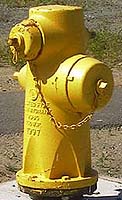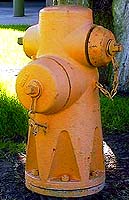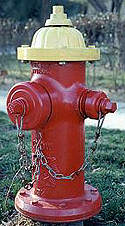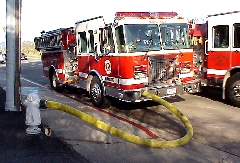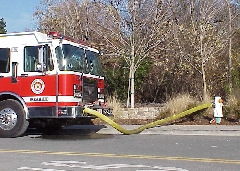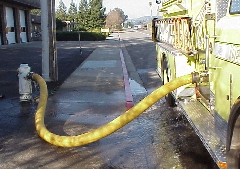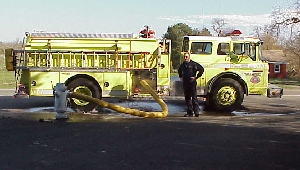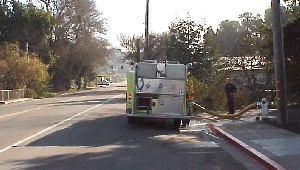© 2000 Capt. Willis Lamm, Water Supply Officer, Moraga-Orinda (CA) Fire DistrictBackground Criteria Storage Distribution Hyd. Design Placement Installation Codes & Markings Applications Codes & Standards
|
| PRACTICAL APPLICATIONS |
| While it may seem insignificant, outlet orientation can have a pivotal impact on the efficiency of fire crews making hookups to hydrants. In locations where main pressures are sufficient to allow fire companies to lay supply lines directly to engines at the scene, outlet orientation is primarily an issue of convenience and getting lines past parked vehicles. In locations where main pressures are low and engines have to pump directly from fire hydrants, how outlets are oriented can make the difference between a fast and efficient hookup versus a complicated procedure. |
Two-outlet hydrants can be
configured in either of two ways. How the
pumper outlet faces can make a significant
difference.
|
| As a general rule, hydrants are either oriented with the pumper outlet perpendicular to the curb which faces the street, or with the pumper outlet set at a 45 degree angle to the street. Whether an agency chooses a perpendicular or 45 degree configuration depends on the type of hydrant chosen, the operations of the fire department, and prevailing conditions such as on-street parking that may restrict hydrant access. |
A dry barrel 2-outlet hydrant
|
| Many newer fire apparatus are equipped with gated preconnected front suctions for making direct hydrant connections. This suction connection is often located at the extreme right side of the front of the apparatus cab. This design is most compatible with a hydrant that has a pumper outlet that faces away from the engine at a 45 degree angle. This configuration allows the fire engine to spot relatively close to the curb, blocking less of the street (which may be needed by other fire apparatus) and at the same time minimizing the chance of kinking the supply hose and adversely impacting fire flows. |
Nice, compact hookup
|
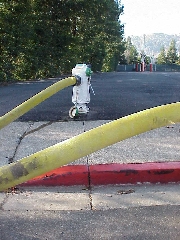
| A hydrant orientation where the pumper outlet faces away from the apparatus at a 45 degree angle has several operational advantages over "mirror" orientations where the outlet faces toward the apparatus. When positioning the apparatus at the hydrant, a correct position will usually be obtained when the hydrant is just forward of the right hand windshield "A" post in the driver's view. Taking a hydrant on the right side of the street (with the pumper outlet facing away) will result in a nice, rounded semi-horseshoe layout that is not likely to kink. |
| Taking a hydrant on the left side of the street (with the pumper outlet facing toward the apparatus) usually involves spotting the apparatus when the hydrant is just forward of the left hand windshield "A" post in the driver's view. Since there is greater distance between the front suction connection and the hydrant, a nearly straight and kink-free hookup is obtained. |
Opposite side of the street
|
|
| |
|
If a vehicle is actually blocking the hydrant, the 45
degree offset provides room to attach large diameter hoses,
adapter fittings and other equipment such as 4-way valves.
Right: An actual fire operation in
|
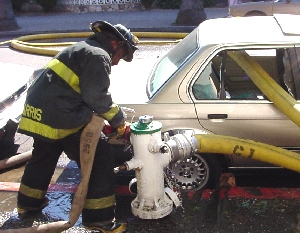
|
|
|
A clean, kink free layout
|
Hydrant is even with rear axle
|
Tight position, roadway kept clear
|
|
| |
| Continue to Part 9 |
Return to Part 7
Return to Information Section
Return to Water Supply Section
Background Criteria Storage Distribution Hyd. Design Placement Installation Codes & Markings Applications Codes & Standards
|
